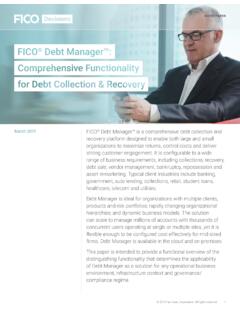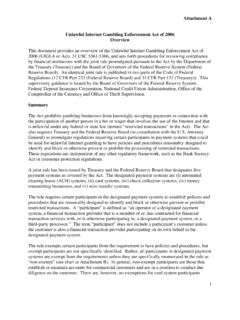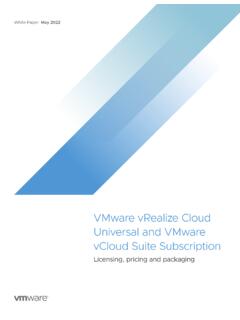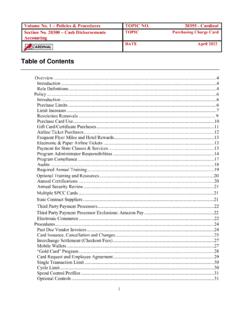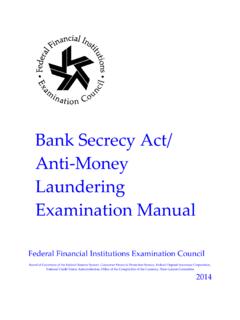Transcription of How to perform a financial institution risk assessment
1 How to perform a financial institution risk assessmentThis quick reference guide walks you through three steps to perform a risk assessment for your FI, and includes examples and best REFERENCE GUIDE 1 OVERVIEW1 TABLE OF CONTENTS1 - Risk assessment Overview ..2 Introduction ..2 Tips and tricks ..3 2 - Performing a Risk assessment ..4 Performing a risk assessment for your financial institution ..4 Three steps to complete a risk assessment ..5 Step 1: perform a risk assessment based on risk factors ..6 Step 2: Provide narrative guidance to show understanding and justification for risk ratings.
2 10 Step 3: Identify mitigation efforts and acceptable level of risk..113 - Managing Risk ..12 Helpful hints for managing risk ..12 Factors to consider when deciding whether or not to automate ..1323 MANAGING RISKS ectionsPERFORMING A RISK assessment 2 2 There are various levels of risk for a financial institution . institution risk takes into account all risk factors and combines them into an overall risk assessment . A financial institution risk assessment is a measure of the potential threats present at, and for, your financial institution . This encompasses: Customers Entities Transactions Geographic locations Products Services Employee trainingThis should also include any other factors that affect the regulatory compliance and fraud risk health of the organization.
3 Your risk assessment should drive your policies and procedures, which help mitigate and manage those risks. A thorough risk assessment considers BSA/AML, fraud, OFAC, and institution -specific factors, such as business lines and subsidiaries and how all of these factors quick reference guide provides a brief, summarized version of the requirements and can help you perform a financial institution risk assessment . When your examiner asks where your FI stands with risk, this guide can help you feel confident and assessment Overview A risk-based approach requires institutions to have systems and controls in place that are commensurate with the specific risks of money laundering and terrorist financing facing them.
4 11 Study Guide for the CAMS Certification Examination, Ch. 4, p. 183 SECTION 1 3 Ensure your risk assessment is tailored to your FI:Be as specific as you can with the information at your not to generalize or be too background research and material, ask for a copy of an existing risk following resources can help you get started:Peers and consultantsOnline forums and search enginesRisk assessments are changes over time and should be continuously monitored and reassessed. Learn about any potential exposures and detail a s better to know where you stand in terms of risk so you can put appropriate measures in place to protect your FI and your you are able to justify your want to see a logical thought process in your risk assessment that justifies your analysis and assessment OverviewTips and tricksSECTION 1 4 Performing a risk assessment for your financial institutionExaminers want to know that your financial institution is aware of the risks that are present and is managing them adequately.
5 This quick reference guide walks you through three steps to perform a risk assessment for your FI, and includes examples and best know what products and services your FI offers, so your FI risk assessment helps you know: the risks they present the number of low, medium, and high risk customers the types of products and services they use their typical transactions and expected behavior the geographic locations that are in use by your customer base which ones present the most risk to youYou should also be able to talk about the reasons behind your decisions, and have a plan in place to mitigate the risks that you can control.
6 High risk can help you determine which individuals and groups require greater s a good practice to start with a clear purpose for the existence of a risk assessment and an awareness of your risk limitations. This will help ensure that your institutional risk assessment is aligned with your FI s intended risk profile. Further to this, when new products and services are added, the risks should be evaluated prior to implementation to ensure they align with your FI s policies and a Risk AssessmentSECTION 2 5 Three steps to complete a risk assessment : perform a risk assessment based on risk Identify specific risk Take a deeper dive into identified risk categories and rate narrative guidance to show understanding and mitigation efforts.
7 ( , monitoring, tracking, acceptable risk levels).These steps are outlined in more detail on the following a Risk AssessmentSTEP1 STEP2 STEP3 Risk can be broken down into general categories:Prohibited (not tolerated at the FI)High risk (significant, but not prohibited)Medium risk (additional scrutiny is merited)Low risk (baseline risk)Categorizing RiskSECTION 2 6 perform a risk assessment based on risk The FFIEC BSA/AML Examination Manual outlines three main risk categories: products and services, customers and entities, and geographic locations. The following lists provide the steps for creating a risk assessment and the reasons each category presents risk along with examples of what is included in each risk Identify Specific Risk CategoriesProducts and ServicesProducts and services have varying degrees of risk at each institution .
8 The riskiest ones involve the heaviest possibility of being used for money laundering or terrorist financing. To help determine how to rate each product and service, you can ask yourself: Does a particular product or service enable significant volumes of transactions to occur rapidly; afford plenty of anonymity; require identification to complete; or have unusual complexity?Some products and services that are particularly risky include private banking, offshore international activity, loan guarantee schemes, wire transfer and cash-management functions, and transactions in which the primary beneficiary is not disclosed.
9 Electronic funds payment services prepaid access, funds transfers, transactions that are payable upon proper identification, third - party payment processors, remittance activity, automated clearinghouse transactions (ACH), automated teller machines (ATM) Electronic banking Trust and asset management services Monetary instruments Foreign correspondent accounts bulk shipments of currency, pouch activity, payable through accounts, dollar drafts Trade finance Services provided to third - party payment processors or senders Private banking Foreign exchange Special use or concentration accounts Lending activities, particularly loans secured by cash collateral and marketable securities Non-deposit account services non-deposit investment products and insuranceExamples of products & services2 Note.
10 The lists of products and services, customers and entities, and geographic locations are not complete. For more detailed information, refer to the FFIEC BSA/AML Examination a Risk AssessmentSECTION 2 STEP1 7 Customers and EntitiesCustomer and entity risk is extremely complex. Certain types of customers may pose heightened risk. Through customer due diligence (CDD), a financial institution gains an understanding of the types of transactions in which a customer is likely to engage. This helps identify potential risk and determine an appropriate level of monitoring. Enhanced due diligence (EDD) is applied to those deemed to pose higher risk and their activity should be reviewed more closely when an account is opened, as well as throughout the term of the relationship.

